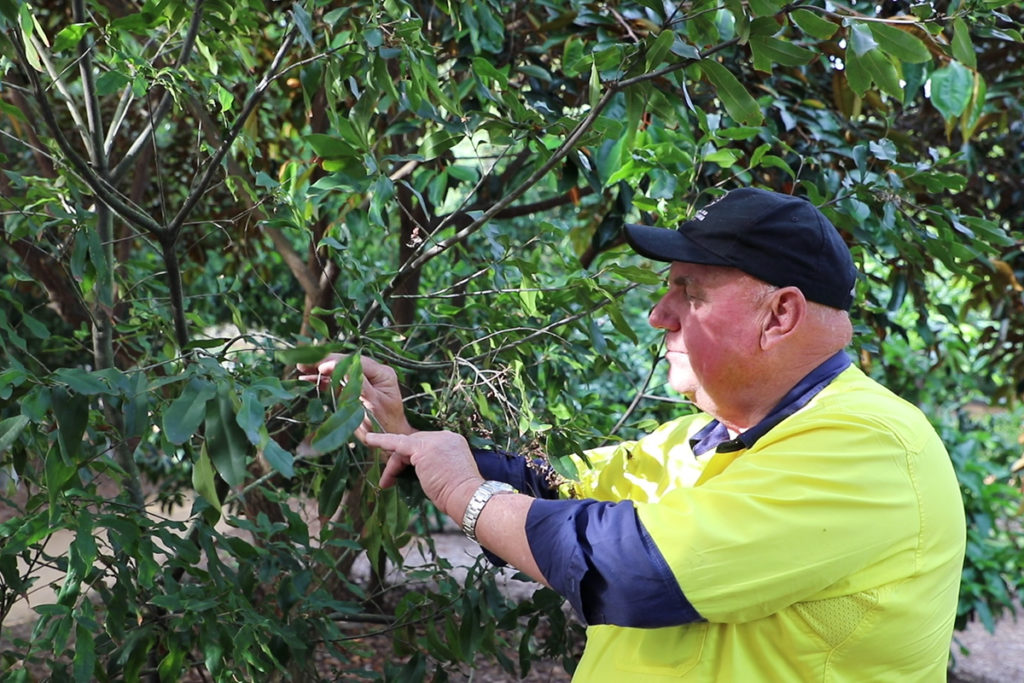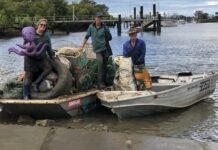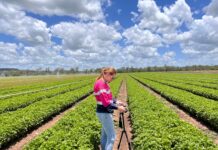
Sitting in the lush Bundaberg Botanic Gardens are four wild macadamia trees critical to the conservation of the species with an ability to boost the agricultural industry.
Macadamia Conservation Trust member Brice Kaddatz said one of the trees, the endangered Macadmia jansenii, was an extremely rare species discovered in a dry Gin Gin gully in the 1980s.
He said it had the opportunity to turn the macadamia industry on its head.
“We believe its characteristics will enable it to be used for crossbreeding purposes to actually allow macadamias to be grown in areas that currently they haven’t been grown in,” Mr Kaddatz said.
“There has been some crossbreeding done with it by the specialists and they produced some edible kernel crossbreeding with a 60% kernel recovery – that is 60% of the weight of the nut was kernel rather than shell – and that’s opposed to an industry standard of about 33%.
“So in the future they will play a big role.”
Mr Kaddatz was present at the planting of the four species – the integrifolia, tetraphylla, ternifolia and jansenii – in 2009 and he believed they would play a crucial role in conservation of the species.

“The bigger picture is that these wild macadamia trees have still got a major role to play in terms of developing new cultivars – new varieties – in to the future.
“That’s one of the primary reasons we want to see them conserved.
“It would be the death knell of the industry if we lose the wild trees.
“That is the danger and that’s why we need to alert Australians to the fact that this is an absolute icon. There is no question about that.”
Botanic Gardens to expand wild macadamia plantings
Bundaberg Regional Council environment spokesman Cr Wayne Honor said the conservation project in the Botanic Gardens would soon be extended.
“We will soon be planting 38 young Macadamia jansenii in the gardens,” Cr Honor said.
“They are genetic clones of the ones growing in the wild near Gin Gin, which are endangered and threatened by fire and weeds.”
He said growing these rare macadamia species in the Botanic Gardens made a very important contribution to plant conservation.
“It allows the general public to easily see an endangered species, and raises awareness. It also helps to safeguard the species for the future.
“This project is a great example of how the Bundaberg Botanic Gardens meets international criteria: holding collections of living plants for scientific research, conservation, display and education.”
He said the macadamia industry was the third largest horticultural export in the country but many Australians didn’t know every species of macadamia was native to Australia.
“Regardless of where you find a macadamia anywhere in the world it had its beginnings right here.”
Recent research has revealed that every macadamia tree in existence can be traced back to a “mother” tree west of Gympie.
“That tree still exists,” Mr Kaddatz said.
“That’s where they collected the original seed nuts, took them to Hawaii back in the 1800s and the Hawaiians developed the first commercial cultivars from that.”
More about the rare Macadamia jansenii
Mr Kaddatz said the jansenii produced a small nut about the size of a thumbnail with a very thin shell.
In the 1980s a small patch of 60 trees was discovered in the Gin Gin area however Mr Kaddatz said another small family of trees was recently found.
“We are a little better off than we thought we were,” he said.
These macadamia trees are not the only rare trees that call the Botanic Gardens home with the facility also housing the endangered Isis Tamarind.








We have a very old macadamia tree on our property. It would be over 43years old. Could it be the variety you are discussing in this article? How can we find out if it is the variety in the article?
Comments are closed.